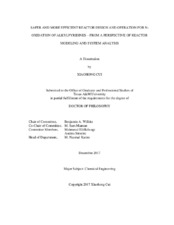| dc.description.abstract | This work aims to promote continuous manufacturing of fine chemicals and pharmaceuticals by proper reactor design and operation. These synthetically important yet potentially hazardous chemistries are conventionally carried out in batch/semi-batch mode, which is subject to challenges including cumbersome scale-up (e.g., mixing and heat transfer limitation), safety concerns (large reaction volume and chemical inventories), and product quality variation from batch to batch. Continuous processing could potentially address these issues by (i) reducing reactor volume without compromising overall throughput, (ii) enhancing mixing and heat transfer, and (iii) enabling better product quality control via steady-state operation.
For illustration, two continuous reactor configurations for a model chemistry, i.e. N-oxidation of alkylpyridines, whose products are key intermediates for drug syntheses and agricultural compounds, are studied based upon kinetics and reactive hazards information obtained from calorimetry studies in order to perform the chemistry in a more scalable and inherently safer fashion.
The first reactor studied is a conventional stirred-tank reactor which could facilitate control and instrumentation owing to ideally homogeneous distribution and lower capital costs for changeover from batch to continuous. Classical reaction engineering/system fundamentals (e.g., first-principles reactor modeling, system dynamics and stability) are applied to analyze reactor steady-state multiplicity and oscillation phenomena that may bring about serious incidents. Reactor design and operation conditions as well as start-up strategies and worst-case scenarios are systematically investigated to address process safety concerns and balance reactor efficiency.
The second reactor analyzed is a novel tube-in-tube membrane reactor, which facilitates controlled radial slip of hydrogen peroxide into co-current alkylpyridine flow driven by an applied trans-membrane pressure difference across the inner porous ceramic tube. Design rules in terms of relative permeation and reaction rates are established in terms of desired outlet alkylpyridine conversion and peroxide residue using a single isothermal tube-in-tube unit. Multi-unit module design is then investigated to optimize productivity and module dimensions while balancing heat transfer capability to maintain isothermal operation in practice and preventing mass transfer across the unit boundary to ensure isolation. | en |


